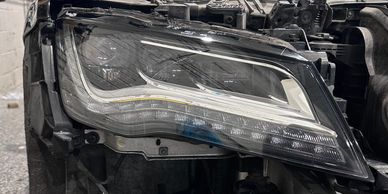We often get inquiries regarding ceramic coatings, their warranty period, as well as their longevity. We are strong believers that educating our clients is the first step in deciding which service suits them best. There is a lot of misinformation when it comes to coatings, their longevity, layers, etc. In this section, we will shed light on these issues.
The first misconception is that all ceramic coatings carry the same strength, with just different warranty periods. This is incorrect. A 1 year coating has no where near the same hardness, scratch resistance, and overall durability when compared to a Multi-Layer Ceramic Pro coating.
We do not offer 1 year coatings for this reason; they are a waste of our clients money, and someone seeking a 1 year coating may as well maintain their paint with a spray sealant, because that is essentially what a 1 year coating is. Zero protection, only a hydrophobic layer.
Another common inquiry we get is regarding layers. A proper ceramic coating will be comprised of a base coat, and a topcoat. The base coat is what gives you the strength benefits, such as marring resistance, and acts as the foundation of the sacrificial layer. The basecoat in a ceramic coating is not hydrophobic. The topcoat, often the second layer, is what gives a coating system hydrophobic behaviour, extreme shine, and gloss.
Most coatings in fact, can only be installed with one single basecoat, and one single topcoat. Ceramic Pro is the exception, as you can layer multiple coats of base coat, to genuinely increase the coating thickness. Competitor coatings simply reject additional layers (installers will apply it, but it does not bond to the previous layer). Keep this in mind, that you could theoretically apply these competitive coatings base several times, and not be doing anything other than ensuring coverage.
More layers does not mean more protection, with Ceramic Pro as the exception. Ceramic Pro is the only patented, genuinely layerable coating on the market.
The last point we will make is not all coatings are created equal. Not all 5 year coatings are the same strength. There are many 5 year coatings on the market that may last 5 years, but with poor resistance to defects, and rapidly diminishing gloss. There are also coatings on the market that boast a 5 year warranty, but last less than a year. We have thoroughly tested all available coatings on the market, and there is nothing that compares to a properly installed Ceramic Pro coating. A Ceramic Pro Silver Package installed by Toronto Buffing increases the hardness of the paint, making it more difficult to swirl, while providing stable gloss for the set warranty period.
Many competing shops push another popular brand of coating, simply because the cost to the installer is much less. Ceramic Pro coatings have a high material cost, almost triple the cost of this popular 3 letter coating brand. The ingredients in Ceramic Pro's basecoat and topcoat are extremely potent, and toxic. The carrier agents (solvents) used to bind the coating to paint are very strong. Once it is cured, it can only be removed with extreme abbraision. This is what you want when it comes to a coating, Hard to remove, means hard to defect. The competing coatings are removed or severely compromised in most cases with a simple claybar, or hand wax. This is due to cheaper carrier agents, and a less than ideal bond on a molecular level.
The other reason competition push these lesser coatings, is because of their ease of installation. These products can be installed with little to no experience. But as is the case with many things in life, the easy way is not always the best way. Ceramic Pro is notoriously difficult to install, due to the strong nature of the product. It immediately binds to the surface, requiring skill, precision, and dudiligence when leveling. Installing a Ceramic Pro coating is a quite laborious, where as competing coatings are not.
We rather install a coating that makes us less money, but performs exceptionally well. We have watched our Ceramic Pro Silver Package perform for it's 5 year period time and time again. We have watched (and have had to remove) these competing coatings many times over the years.
We always urge clients to not jump the gun, and not be enticed by low price, and warranty periods. Focus on the product, its history, and the installers track record.











